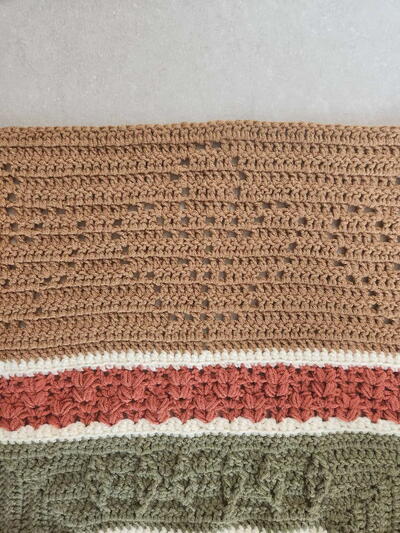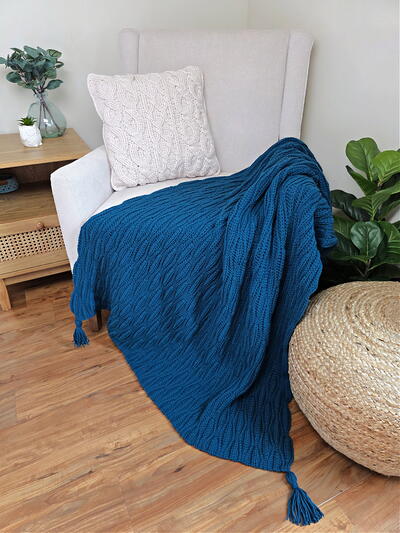80 Reader Tips for Beginner Crocheters
80 Reader Tips for Beginner Crocheters
Gauge and Tension Tips
Understanding Crochet Stitches
Relax, Take Your Time, and Don't Give Up!
Practice Makes Perfect
Understanding Crochet Patterns
First Crochet Projects
More Great Tips for Crochet
Have Fun with Crochet!
We've all been there. At one point in time, everyone was a beginner crocheter. So we asked our readers for tips so we can help the beginners out there. From simple words of encouragement and great tips for everyone to try, 80 Reader Tips for Beginner Crocheters is full of great crochet tips from readers just like you. Take a look and you may find a tip or two that you've never thought to try!
Gauge and Tension Tips
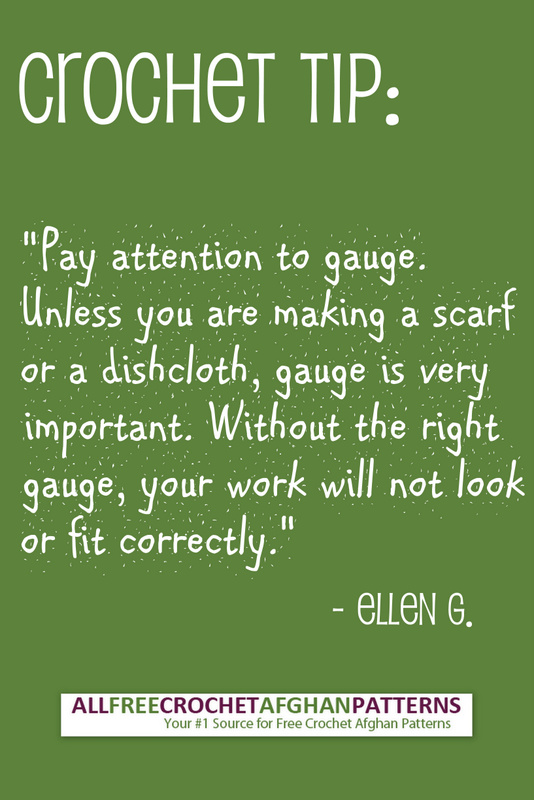 Crocheting for the first time can result in uneven gauge and tension problems. These readers have all been there and they have some great tips as to why gauge is important and how to acheive proper gauge.
Crocheting for the first time can result in uneven gauge and tension problems. These readers have all been there and they have some great tips as to why gauge is important and how to acheive proper gauge.
-
"Pay attention to gauge. Unless you are making a scarf or a dishcloth, gauge is very important. Without the right gauge, your work will not look or fit correctly." - Ellen G.
-
"Do NOT crochet tightly. It only causes frustration when you’re first learning. My mother taught me this. I still crochet rather loosely, but it’s easier to tighten up and work on consistent tension later." - Carmen
-
"Make your starting chain loose or else do it with the next size up crochet hook. It will make doing your first pattern row easier. If size matters, make sure you do a practice piece so you know that your gauge matches the directions before starting your project. Until you are comfortable working on your projects, don’t try to do anything else simultaneously." - Carol H.
-
"Work LOOSELY. It is so much easier when you can get your hook through the work! That’s the biggest mistake I see beginners making. The second one is trying to go too fast when first starting. You need to go slowly and deliberately as you learn the stitches. As you progress you can gain speed." - Lorrie P.
-
"Keep your tension uniform. You do this by holding the yarn properly, so that you can easily control how loose or tight you make your stitches." - CJ
-
"I have been crocheting since I was about 8 years old. The best tip is to always make a swatch to make sure gauge is right. Everyone crochets a little differently - some looser some tighter. Do not obsess about it make a swatch use a different size hook if you need to. Relax and enjoy, I have received so much enjoyment from crocheting. It is such a stress reliever. Practice and make those swatches!" - Frances H.
-
"Learn to chain and get used to holding the hook and learn to relax with it. If you’re holding it tight your stitches will be too tight. If you hold it to loose then your stitches will be too big. Just do chains for a little while until you have it perfect - not too tight or too loose. It takes time and practice. Try doing a pot holder first using a hook you feel comfortable with and do single crochet back and forth. You’ll learn practice makes perfect. And if you have to rip it out down worry some of the best crocheters have to undo the work sometime." - Elouise Holley
- "Stretch your fingers wide wrapping the yarn around the inside/out of your pinky finger over the back of your hand and keep and hold the proper tension in order for your each stitch to come out the same." - Gaynell H.
Understanding Crochet Stitches
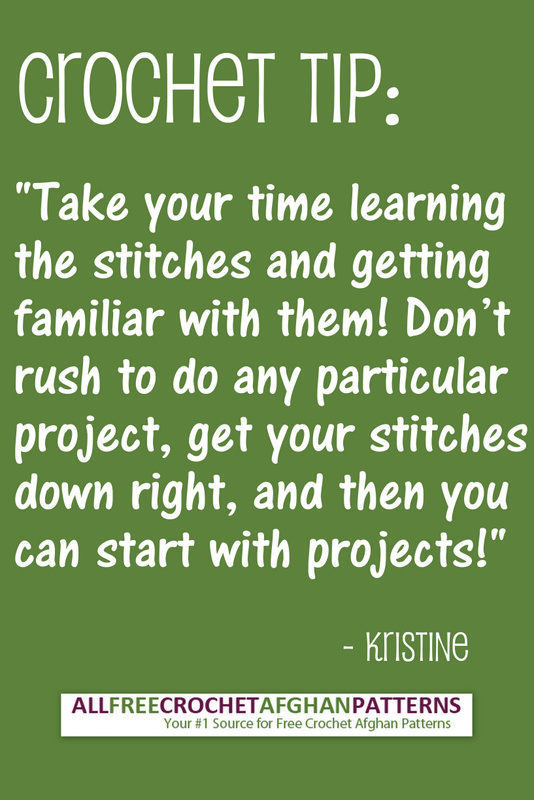 Crochet can seem like a foregin language to a beginner, so it's best to sit down and understand what you are about to do. These readers know how important it is to count your stitches, learn new stitches, and use stitch markers when crocheting.
Crochet can seem like a foregin language to a beginner, so it's best to sit down and understand what you are about to do. These readers know how important it is to count your stitches, learn new stitches, and use stitch markers when crocheting.
-
"I would explain to them that a crochet is a yarn over and pulling through two loops. Double is doing it twice, treble is doing it three times etc. I would have them start out on a piece with maybe twenty chain stitches and have them keep going back and forth and that a stitch is usually both loops on the top. Explain to them that the chain(s) up at the end of the row count as a crochet. They should make sure they have twenty stitches at the end of each row. Then practice, practice, practice until they see even tension." - Virginia B.
-
"Start with simple stitches and practice them until they look great and even. A beautifully stitched piece of single crocheted or double crocheted stitches looks better than a poorly stitched piece of fancy stitches. Once you have the simple stitches down, the fancier stitches will fall into place easier. Enjoy your new art and have fun with color and don’t be afraid to try something new, just do it!" - Cindy
-
"Always count your stitches! It’s way too easy to accidentally skip the previous row’s turning chain or to just skip a stitch anywhere. When I was learning, not counting my stitches after each row frustrated me many more times than was necessary because I was too lazy or overconfident to count them every row." - Melissa
-
"Take your time learning the stitches and getting familiar with them! Don’t rush to do any particular project, get your stitches down right, and then you can start with projects!" - Kristine
-
"The 3 most important things are 1. Count your stitches 2. Use your stitch markers and 3. READ THE PATTERN carefully all the way through before beginning. No shortcuts on those and it will look like it should when you are done!" - Jenna W.
-
"Use your stitch markers! It helps with learning to count." - Sheila
-
"Use a safety pin or a piece of contrasting yarn to mark your rows and/or stitches, so you don’t lose your place. Invariably someone will say something to you while you are trying to count and you will lose your train of thought." - Carol H.
-
"Branch out of the chain stitch. Watch lots of tutorials, take your time. Don’t beat yourself up if you have to pull out rows, it is part of the learning process. Just take your time and make progress with a learning curve." - Marilyn R.
-
"Once you have learned the basics, do not be afraid to try new stitches. With practice they will become easy as well." - Donna R.
-
"Count, count, count…it's the best way to stay on track and keep things even." - April C.
-
"Make sure you count the number of stitches on every row. It is very easy to lose a stitch when you are turning at the end of the row. I have been crocheting for over 40 years and find that when I rush and fail to count my stitches it usually ends in having to rip back my work. Rushing does not save time; it only slows you down in the long run. Needlework is meant to be enjoyed as a process. Savor each stitch instead of rushing headlong to finish your project." - Sheila
- "Start by doing one stitch for say a half hour, then go on to a new stitch. That way you can see how you are progressing in order to get to know each stitch." - Sharon D.
Relax, Take Your Time, and Don't Give Up!
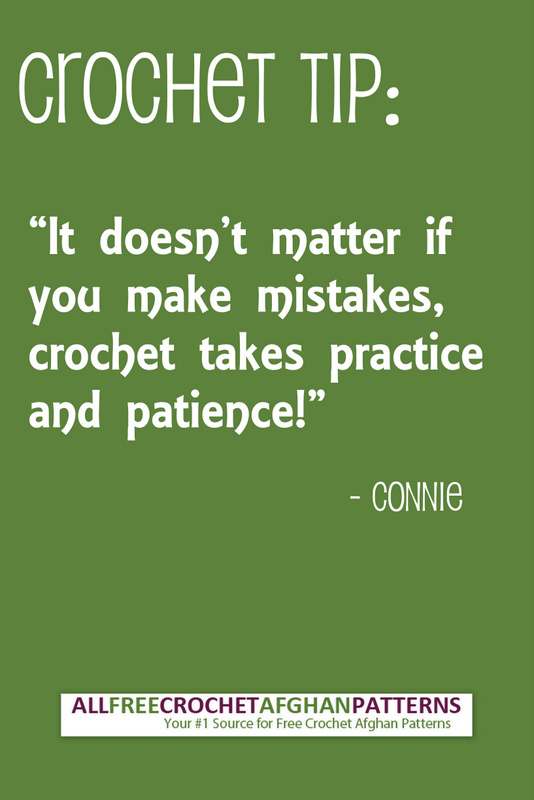 Take a deep breath and relax. Crocheting is a relaxing hobby and these readers have some encouraging words for the beginner crocheter.
Take a deep breath and relax. Crocheting is a relaxing hobby and these readers have some encouraging words for the beginner crocheter.
-
"Slow down! Make your movements slow and deliberate, so you can watch what your muscles are learning to do." - Shirley V.
-
"My tip would be to stay relaxed. You’re learning a new hobby, not trying to defuse a bomb that’s about to go off. A mistake can be undone, it won’t destroy all life on the planet! It’s almost painful sometimes to watch a new crocheter, with their jaw set, teeth grinding, forehead furrowed and eyes all squinty, trying to stab the needle into the right place. Although it sounds counter-intuitive, I find that splitting their attention by keeping them engaged in a non-crochet conversation helps them avoid tensing up so much." - KittenWithAWhiplash
-
"My advice is always RELAX! It doesn’t matter if you make mistakes, crochet takes practice and patience! (It seems to have worked wonders with everyone I have met who were seriously afraid of learning!) Also I start by teaching them to chain until they feel comfortable holding the crochet hook!" - Connie
-
"Go slow…Take your time…Don’t give up! Watch a lot of YouTube videos." - Kriss
-
"My #1 tip for new crocheters is ‘don’t give up!’ Your first lesson (chain, and single crochet in to the chain) is ALWAYS the hardest because you are learning not only a new craft but training your brain and hands a new way to work and move. And, by the end of your lesson, you will know 100% more than you did before you started. It just gets easier after the first lesson. So, don’t give up!" - Beth M.
-
"Don’t be afraid to pull out your work and try again! … start with something easy, where gauge doesn’t matter … like a baby blanket, a hot pad, scarf, etc, and NEVER give up because of how your first project turns out." - Deb G.
-
"My #1 tip for crochet beginners is to never give up. If you really want to learn, keep trying. I taught myself when I was 10 years old. I learned the chain stitch first, then the single crochet, double crochet and so forth.. I eventually learned how to read crochet instructions by reading and crocheting the stitch. Basically it was trial and error at first, but I never gave up. I wanted to crochet so badly. If I got frustrated, I would lay it down and come back to it later. Always hold your thread snug but not tight. Good luck and happy crocheting. I am now 74 years old and have made and sold many baby blankets, afghans, sweaters, hoods, scarves, and dishcloths." - Wilma
-
"Rome wasn’t crocheted in a day. You have to start somewhere, so just start and don’t give up. Try, try again." - Melissa
-
"The yarn is going to do whatever you make it do. If it’s all in knots, it’s because you knotted it. If it’s beautiful, it’s because you made it beautiful. So just relax and don’t rush." - Melinda D.
-
"Relax! It’s not going to be perfect the first time and makes sure to understand the terms. If you don’t then it will seem like a different language. That’s where I use to lose people because they had no idea what I meant. Practice! Unless you are gifted then you will need to practice the stitches until you get a nice uniform look. Start with simple projects like coasters, place mats, rugs or blankets. If you follow a pattern, please make sure to check your gauge. If you mess up, it’s ok because you can unravel it and start over. Most important thing is to relax. Yes, I said it again. The art of crochet is meant to be fun! Enjoy yourself and breathe." - Rachell
-
"Don’t ever give up. My grandmother, my mother and the neighbor that taught me to knit, all tried to teach me how to crochet over the course of many years. I did not learn until I was expecting my first child, bought a book and taught myself. The best part is I helped my mother who had trouble understanding written patterns, but could crochet from a swatch. No matter what just keep trying!" - Peggy H.
-
"Don’t stop. The more you crochet, the easier it will become, the more it will make sense, and the more confident you will become." - Mearla V.
-
"Start slow…have patience with yourself….and remember….40 years from now it will all be easy….oh and pick the colors you like best to work with….that way it’s always you in the process." - Darlene K.
- "My number one tip is be patient. You’re not going to be perfect when you first start and it takes time to crochet so don’t give up. It even takes me time to learn a new project and I have been doing it for 20 years. Being patient will pay off in the long run when you see your project come out nice and pretty." - Micheal D.
Practice Makes Perfect
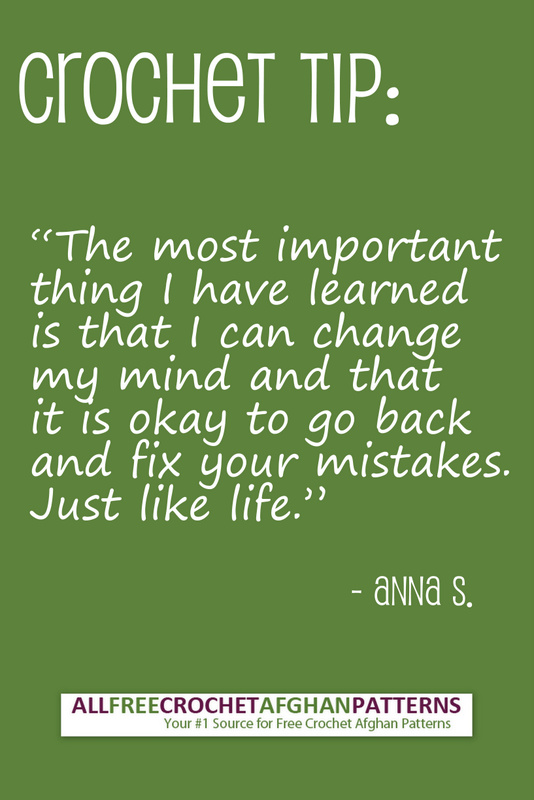 We all make mistakes in crochet, so you're not alone! These readers encourage you to accept that mistakes are okay and that practice will help you in the long run.
We all make mistakes in crochet, so you're not alone! These readers encourage you to accept that mistakes are okay and that practice will help you in the long run.
-
"Don’t worry about making mistakes. There is no shame in pulling stitches out and redoing it correctly. This is how you learn and improve. Just remember it is supposed to be fun!" - Karla R.
-
"Relax! There is no harm…no foul on pulling out stitches and starting again! No project is carved in stone! So…just relax, have fun and enjoy your final effort…it’s all good!" - Robin C.
-
"Start with the basics and Practice…Practice…Practice. Take your time and go slow. . . There isn’t a time limit. Read the pattern carefully and go over the abbreviations before you start. And remember. It’s supposed to be fun, not frustrating. Don’t be afraid to ask for help." - Debbie C.
-
"Practice, practice, practice! I was somewhat frustrated when I first learned to crochet and at times felt like I wouldn’t get it! Finally after months of practice I felt like it finally clicked and everything fell into place from that point on." - Taylor F.
-
"Just take your time. Relax with it. So what if the 1st thing you try looks goofy?!" - Angela F.
-
"The most important thing I have learned is that I can change my mind and that it is okay to go back and fix your mistakes. Just like life. And have fun." - Anna S.
-
"No-one was born knowing how to crochet! Although it’s frustrating to rip out, everyone has to once in a while and it’s just life. If doing a pattern using a new stitch order or technique, always do a practice piece, using a similar yarn, to see if what you’re doing works. Using scrap yarn saves your “new yarn”, bought for the project, from becoming frayed as you practice on the new pattern" - Vickie L.
-
"Start with the basics and have lots of patience. If you get frustrated, put the project down and go back to it later. Sometimes, things just click when you go back to it after calming down. Make pieces that you find appealing and in colors that you like. If you don’t like certain colors, it seems like it takes a lot longer to complete. Finally….never give up! Keep practicing because it DOES get easier" - Gloria S.
-
"Don’t be afraid to rip-it-out!! There is a lot of yarn in this world- don’t worry about using “too much”- there is no such thing. Start simple & practice. Granny squares are the easiest to learn a little bit of everything. You tube is great. And lastly- this is not bigger than you- you will have that ah-ha moment when it will all click! Crocheting wouldn’t have lasted this long if it was really hard." - Mary
-
"Patience grasshopper…learn how to LIKE ripping out your mistakes and starting over. Also, start with something small like a dishcloth and use light colored yarn so you can see your work better. Keep in mind, Ye shall stitch, so shall ye rip!" - Glenda M.
-
"Get a ball of yarn that is easy to work with like Red Heart Super Saver, a crochet hook and practice, practice, practice. It takes time and lots of practice to get it looking good." - Anita
- "If you make a mistake just pull the stitches out. Stick with it and I am sure who ever gets what you’re working on (weather it’s you/family/friend) will love it." - Sara
Understanding Crochet Patterns
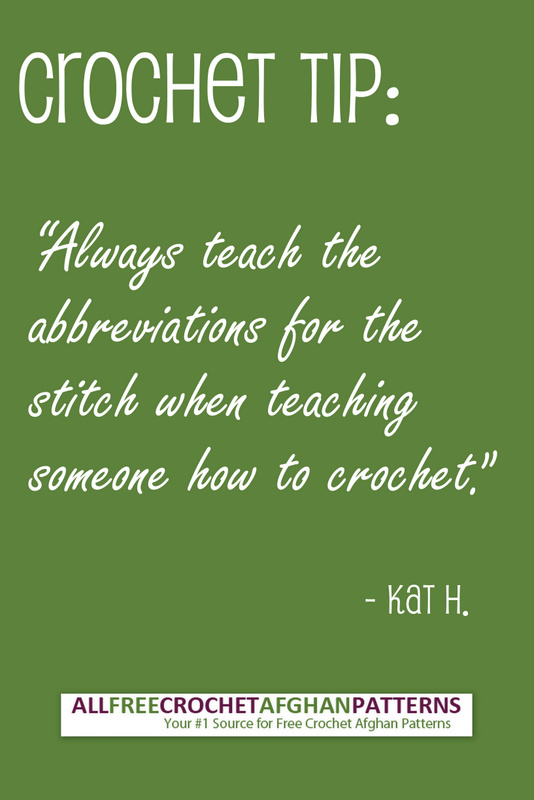 Learning to crochet a chain stitch is just the first step. From the beginning, a new crocheter should start learning how to read a pattern so they can crochet anything in the future.
Learning to crochet a chain stitch is just the first step. From the beginning, a new crocheter should start learning how to read a pattern so they can crochet anything in the future.
-
"If you are confused by a pattern or are having trouble understanding written instructions on how to do a particular stitch, YouTube is a great source for crochet how-tos." - Lori
-
"Please read the directions carefully and relax. Crocheting is such a fine craft." - Jody
-
"My best advice is, if a pattern doesn’t make sense when reading it through, then pick up a hook and some scrap yarn and try it out! After all, ALL crochet is formed from just a very few basic stitches. Also, if there is a technique you are unsure of, Google it. Chances are there is a video demonstration on YouTube. I am a completely self-taught crocheter and I have not yet had any question that the Internet can’t answer." - Jacqui G.
-
"Crochet takes practice but remember you are only limited by your imagination. Try to learn to read patterns. I always teach the abbreviations for the stitch when I am teaching someone. I usually start them on a scarf or dishcloth. But don’t be afraid to learn new stitches and techniques. Also try different mediums: yarn, thread, pharm etc. Have fun once you learn there isn’t anything that you cannot make. Have patience not every learns or crochets at the same speed. Remember there are plenty of you tube videos and website besides people to help you learn. Enjoy!" - Kat H.
-
"Remember that directions from English publications are different than American. But more importantly…..Never miss an opportunity to bud great yarn, and buy – at least 2 (or 5) skeins at a time." - Karen
- "The UK and US have different crochet stitch explanations. Check what terminology the pattern is written in. Australia follows UK terms. This also applies to hook and yarn ply’s, and conversion charts. All of the above can be found freely on the internet." - Cathy W.
First Crochet Projects
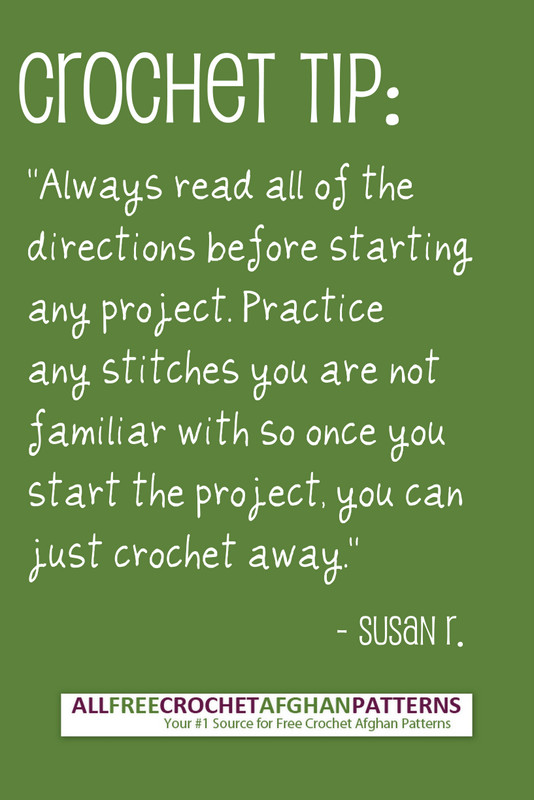 Most crocheters remember their first project, so it's best to pick a pattern that you will look back on and say, "My first crochet pattern was this great pattern!" These readers have some good tips on how to crochet your first project.
Most crocheters remember their first project, so it's best to pick a pattern that you will look back on and say, "My first crochet pattern was this great pattern!" These readers have some good tips on how to crochet your first project.
-
"Just start with something that truly excites you so you keep concentrated then you will enjoy learning never start with something boring like a patch or a scarf." - Ben
-
"I would tell them to start simple and be patient. Diving in first thing with a larger project can be discouraging. Dish clothes and simple baby blankets are great." - Heather
-
"Always read all of the directions before starting any project and practice any stitches you are not familiar with so once you start the project, you can just crochet away." - Susan R.
-
"First pick something simple to make like granny squares or pot holders, use a medium size hook like G or H (they are the easiest to hold and manipulate) next make sure to keep count of your stitches and be patient! It may take a few tries to get your project the way you want it to turn out. Last, enjoy yourself, and relax, don’t put unrealistic time limits on yourself, give yourself plenty of time to finish your project." - Andrea H.
-
"Use light colored yarn so the stitches can be seen easily, a beginner pattern with minimal joining, and don’t get frustrated. You’ll mess up but that’s part of the learning process." - Arhonda B.
-
"Leave a tail at least 6 inches long starting or ending each color. This will give you plenty of yarn to weave back and forth a couple times to hide the end of the yarn." - Happy-Dancing Willow
-
"Start with a small project while you are learning, so it won’t be overwhelming and take months to complete. Finish something small in just an hour or two and it will give you instant gratification and build your confidence level." - Carol H.
-
"The most important thing to teach a new crocheter is patience. Nothing is learned overnight and if you expect perfection while learning you don’t even need to try. I am a very experienced crocheter; if I am trying out a new stitch or pattern I use a light colored yarn and a large hook, I do not try to hit gauge for the pattern, I just want to learn how to do the stitch or pattern and it is much easier to see with a light colored yarn and a large hook, after I get the stitch or pattern down then I use the recommended size hook and type of yarn. Please if you are a beginner, do not use a pattern with lots of color changes. It is also easier to make small items such as washcloths and afghan squares that can be whip stitched together later. The most important thing for a new crocheter is to learn that mistakes happen to everyone and to relax and enjoy the time you spend with your hook and yarn. Happy hooking." - Harriet W.
-
"Find a pattern you love. This keeps your interest, even when you are having issues with tension and hook size." - Emily C.
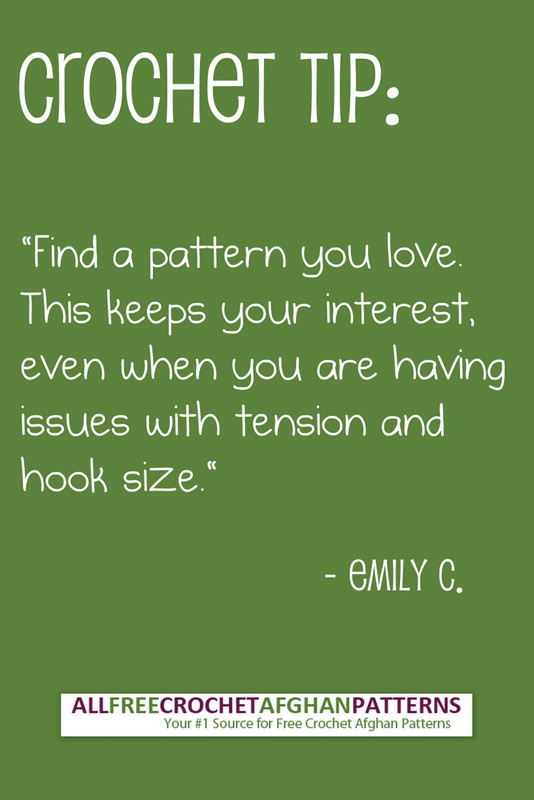
-
"Start with a fairly big hook and chunky yarn, it makes it easier to see what you are doing and how the stitches look. Don’t worry about getting it perfect the first time and start with something easy to gain confidence." - Colleen
-
"Keep your chain flat and do not twist it as you are crocheting your first couple of rows. I am teaching sixth graders to crochet and I have run into that two times this week. Another is to not skip stitches as you are crocheting a rectangle. You may end up with it almost a triangle. Saw that this week too. Have fun, relax, and don’t fuss about tearing out a few rows. I have been crocheting for fifty years and I still need to on occasion." - Joyce M.
-
"Practice, practice, practice…and don’t be discouraged. When I was young, my grandmother gave me a ball of yarn, a crochet hook and I turned the whole thing into a chain. That gave me the ‘motion’ of the needle and an idea of tension. She had me rip it out, and then she started showing me stitches one at a time. If you don’t have a grandma, pick a simple pattern…a scarf with one basic stitch would be good and do that first. Don’t try to do an advanced pattern right away because it could be discouraging.. And remember, sometimes the ‘rip stitch’ is necessary…don’t let it get you down!" - Janine D.
- "My top tip for new crocheters is to pick yarns in colors you REALLY like, because you’ll be pretty slow for the first bit, and will be looking at a project for a long time. When I’m teaching beginners, my default yarn is brightly colored worsted weight cotton yarn, and when they’ve finished their first swatch, it’s immediately useful (as a dishcloth, or doubled and seamed as a potholder). It makes for a fast, fun project!" - Lee M.
More Great Tips for Crochet
These tips are great for new and old crocheters alike!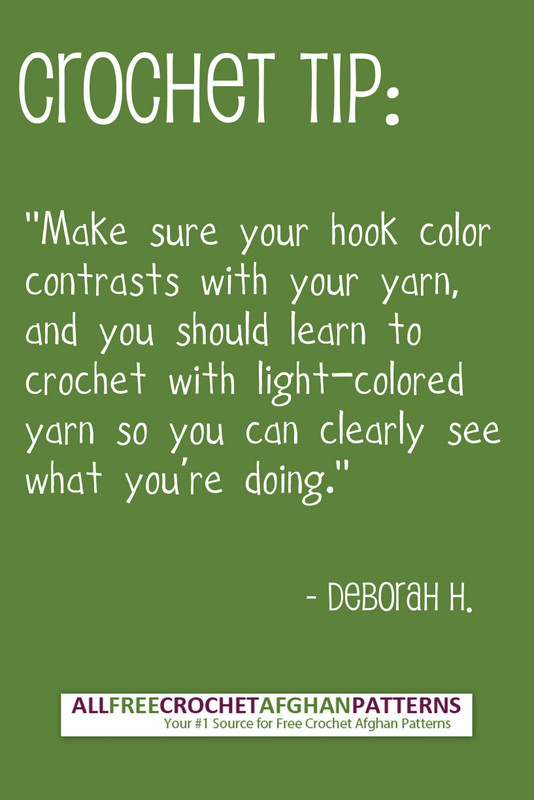
-
"I tell them that they should hold their hook whatever way feels more comfortable to them. I hold mine different than most and it works for me." - Marion
-
"Don’t let someone else tell you how you are supposed to hold your hook! I tried & failed many times to learn crochet from a friend who was determined her way was the only way to hold the hook. And since I had no idea otherwise I believed her. It was only thanks to a deep determination to continue & checking out several books before I realized I could hold the hook anyway that worked best for me!! LOL Go easy on yourself, this is a fun, relaxing & even deeply personal craft to do, so be happy & enjoy it!" - Christine
-
"Make sure your hook color contrasts with your yarn, and you should learn to crochet with light-colored yarn so you can clearly see what you’re doing." - Deborah H.
-
"You will get better; you will find your preferred grip and hook type. Crochet is easy to pull out if you make mistakes. Have patience just keep at it." - Anne R.
-
"Always, always when putting down your work for the evening or whatever, pull up a long loop on your last stitch so that, in the event a child, hubby, cat should move it, pull on it, whatever, they are not pulling out all your stitching. This has saved me a few times. Also, if you have animals in the house, you can put your yarn in a ziplock bag, feed the yarn out the opening, and crochet away. This keeps most of the pet hair off your yarn, hopefully, unless they sit in your lap while you work." - Alice E.
-
"The most important thing when learning crochet… is having a patient teacher! That’s the first characteristic my students compliment me on. What’s funny is…ALL my students and friends mention it…whether they are brand new to crochet or just learning a new stitch." - Dana
-
"Don’t start off with fancy yarn, eyelash or boucle are not easy to work with if you don’t know how to crochet. Yes they are pretty but as pretty as they are they are just as frustrating even to people who have been crocheting for years." - Sara
-
"Lock the cats in a separate room!!! Their curiosity with the yarn is just too funny! Or you could leave them to play with the yarn at your feet for added enjoyment" - Sandy K.
-
"Until you get control of your tension (this takes lots of practice) you should buy an extra skein of each color the pattern calls for. This way if you crochet loosely you will not run out before getting to the end of your project and make sure all skeins match the same dye lot (number printed on label usually near the color name). Skeins on the shelf may look the same but if the dye lot is not identical it can be seen in the finished product and experience has taught me that going back to the same store does not guarantee that you will be able to get the same dye lot on a different day. If you do not have to use the “extra” skeins you can always turn them into hats, scarves or save them up for granny squares." - Kay C.
- "Start out with a friend showing you what to do. That person will correct any mistakes in how you hold the yarn, gauge etc. Videos are good, but there is nothing like an experience to get you going on the right foot!" - Natalie C.
Have Fun with Crochet!
And last but not least, don't forget to have fun!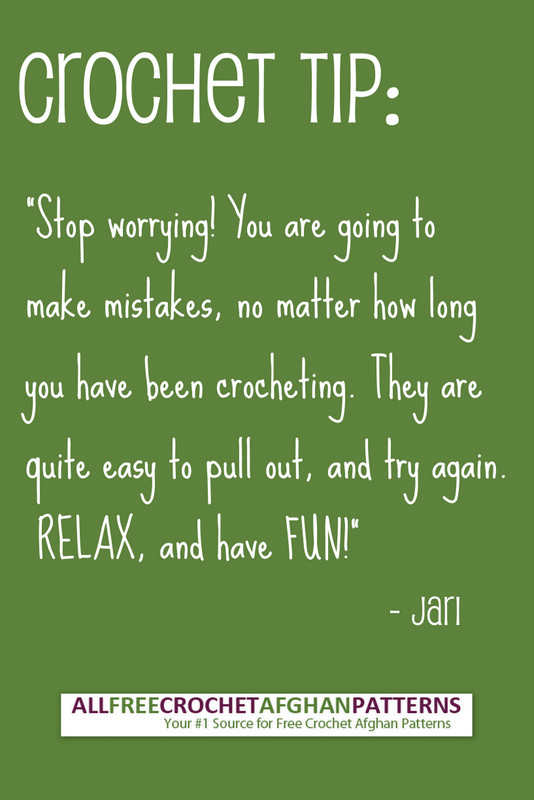
-
"Relax and enjoy it! Crochet is supposed to be fun! Keep your tension loose so your hook can find the stitches, Just play with the yarn, play with the stitches, and you’ll be surprised at how quickly the motions become automatic. And, above all, HAVE FUN!" - Cathy
-
"Know, ahead of time, that mistakes happen. Take it slow. Get used to the yarn, AND your hook. You’ll do “so much,” pull it all out, and start over MANY times. The KEY: Have fun with it." - Dan R.
-
"Stop worrying! You Are going to make mistakes, no matter how long you have been crocheting. They are quite easy to pull out, and try again. RELAX, and have FUN!" - Jari
-
"Relax! It’s supposed to be fun. There is no crochet police because there is no “one right way” to do it." - Theresa
- "Don’t be afraid to try, experiment, play, and have fun." - Jackie
Read NextCluster V-stitch Crochet Tutorial
Your Recently Viewed Projects
Citsme
Aug 19, 2014
ARTICLE Tips for Beginning Crocheters By Nicola Trumbull Editor for AllFreeCrochetAfghanPatterns I have crocheted for many years however I had just set it aside when I moved into this house It could be because my yarn and supplies were put in the attic I haven't been there much Now I want to continue my crocheting for charity and I'm rusty That made me a bit nervous as I have made at least a dozen afghans of different types and stitches and a few of those purposely turned into blankets I have also crocheted squares for Warm Up America I read one paragraph of the Gauge and Tension Tips section to find out the answer to an issue that I am having that now that I remember is so basic I just didn't remember It was at this point I knew that I definitely would benefit from this entire page article and…Read More I printed it so that I could take it with me and refer to it if needed It is also a wonderful shot of confidence from the author and a great reminder And last but not least don't forget to have fun Thank you for making this available to us Great work Also pinned to Pinterest
Tekgyrl
Sep 29, 2013
This is great advice and this is coming from someone who has been crocheting for over thirty years. I have taught the craft and won many awards. Coming from an EXPERT two thumbs up!
angelrich0909 8701 173
Jul 11, 2013
umm the reason i gave a bad rating is because i was trying to learn how to read the crochet
Tekgyrl
Sep 29, 2013
Angel, This is not a reason to give this article a bad rating. The editor takes a lot of time to give us this information from the beginner's level to intermediate levels. I'm sure there is an appropriate set of instructions on the site for you. Its just that you ran across the one that just wasn't for you. If you read through it thoroughly, you would have found other resources. I teach crochet classes often and this article is a lot of what I teach. The main objective in crocheting is NOT TO GIVE UP. Give the article a chance.
Report Inappropriate Comment
Are you sure you would like to report this comment? It will be flagged for our moderators to take action.
Thank you for taking the time to improve the content on our site.

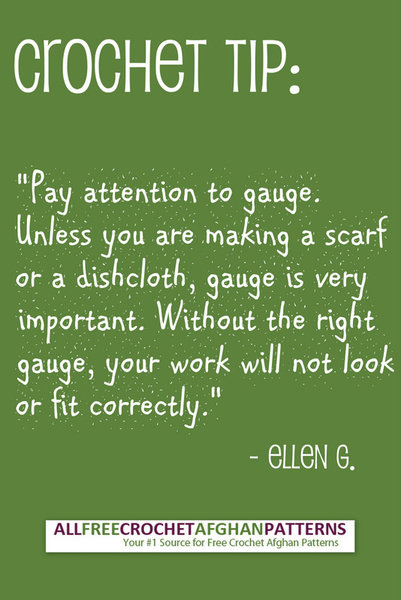
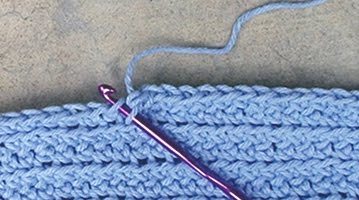

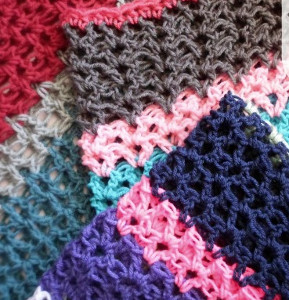

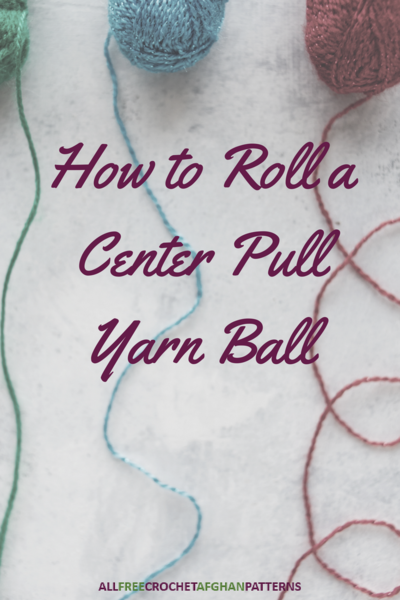
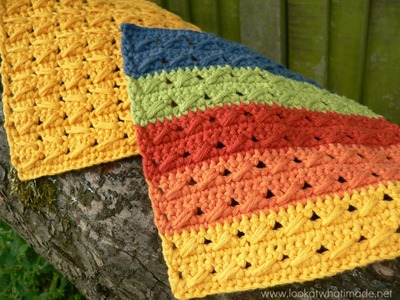
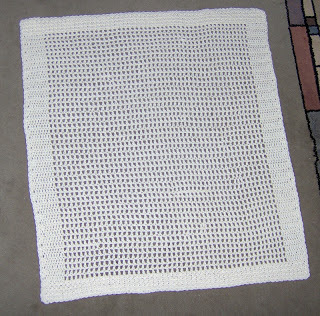

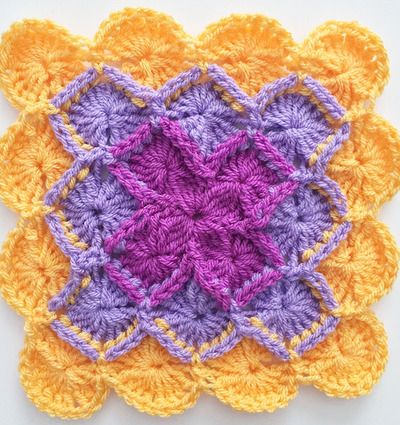
![Yarn Weights Chart [Infographic]](http://irepo.primecp.com/2017/06/336145/Yarn-Weights-Chart-Infographic_Large400_ID-2297604.jpg?v=2297604)


